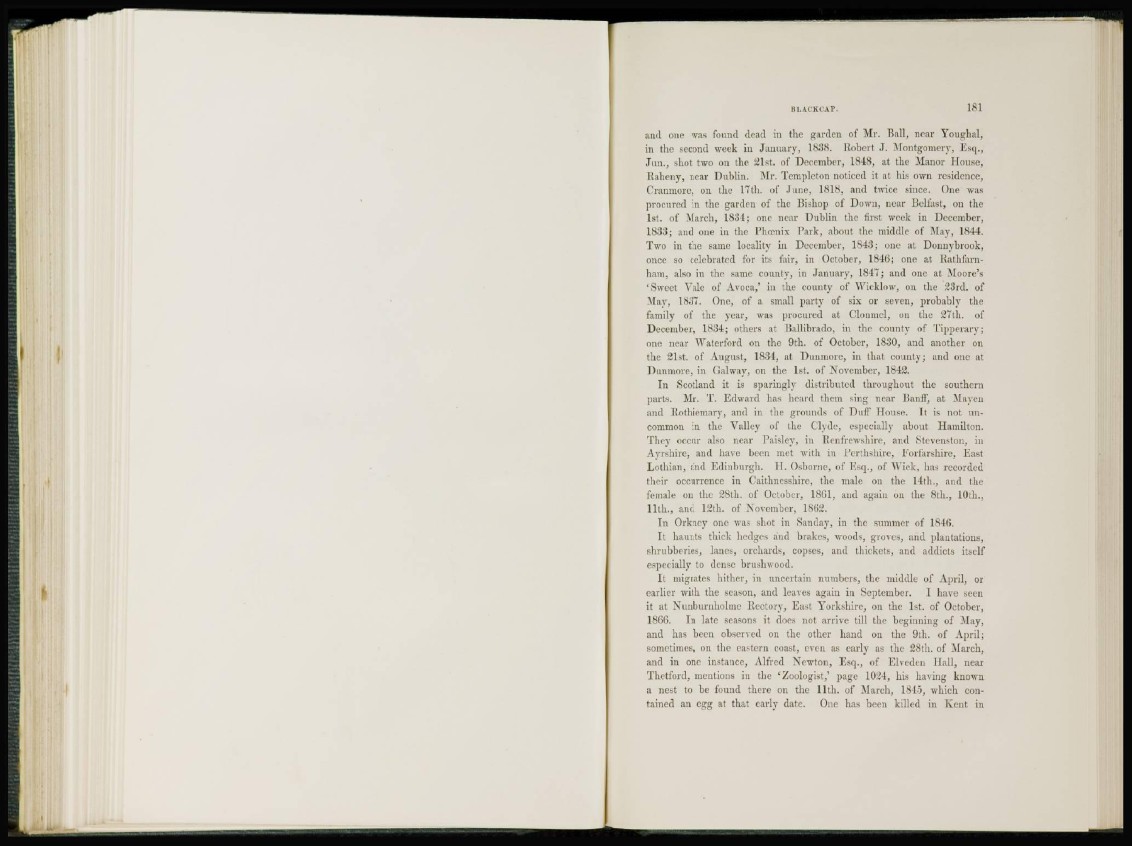
and one was found dead in the garden of Mr. Ball, near Youghal,
in the second week in January, 1838. Robert J. Montgomery, Esq.,
J u n . , shot two on the 21st. of December, 1848, at the Manor House,
Raheny, near Dublin. Mr. Tcmpleton noticed it at his own residence,
Cranmore, on the 17th. of June, 1818, and twice since. One was
procured in the garden of the Bishop of Down, near Belfast, on the
1st. of March, 1834; one near Dublin the first week in December,
1833; and one in the Phoenix Park, about the middle of May, 1844.
Two in the same locality in December, 1843; one at Donnybrook,
once so celebrated for its fair, in October, 1846; one at Rathfarnham,
also in the same county, in January, 1847; and one at Moore's
'Sweet Vale of Avoca,' in the county of Wicklow, on the 23rd. of
May, 1837. One, of a small party of six or seven, probably the
family of the year, was procured at Clonmel, on the 27th. of
December, 1834; others at Ballibrado, in the county of Tipperary;
one near Waterford on the 9th. of October, 1830, and another on
the 21st. of August, 1834, at Dunmore, in that county; and one at
Dunmore, in Galway, on the 1st. of November, 1842.
I n Scotland it is sparingly distributed throughout the southern
parts. Mr. T. Edward has heard them sing near Banff, at Mayen
and Rothiemary, and in the grounds of Duff House. It is not uncommon
in the Valley of the Clyde, especially about Hamilton.
They occur also near Paisley, in Renfrewshire, and Stevenston, in
Ayrshire, and have been met with in Perthshire, Forfarshire, East
Lothian, and Edinburgh. II. Osborne, of Esq., of Wick, has recorded
their occurrence in Caifhnesshire, the male on the 14th., and the
female on the 28th. of October, 1861, and again on the 8th., 10th.,
11th., and 12th. of November, 1862.
I n Orkney one was shot in Sanday, in the summer of 1846.
I t haunts thick hedges and brakes, woods, groves, and plantations,
shrubberies, lanes, orchards, copses, and thickets, and addicts itself
especially to dense brushwood.
I t migrates hither, in uncertain numbers, the middle of April, or
earlier with the season, and leaves again in September. I have seen
it at Nunburnholme Rectory, East Yorkshire, on the 1st. of October,
1866. In late seasons it does not arrive till the beginning of May,
and has been observed on the other hand on the 9th. of April;
sometimes, on the eastern coast, even as early as the 28th. of March,
and in one instance, Alfred Newton, Esq., of Elveden Hall, near
Thctford, mentions in the 'Zoologist,' page 1024, his having known
a nest to be found there on the 11th. of March, 1845, which contained
an egg at that early date. One has been killed in Kent in